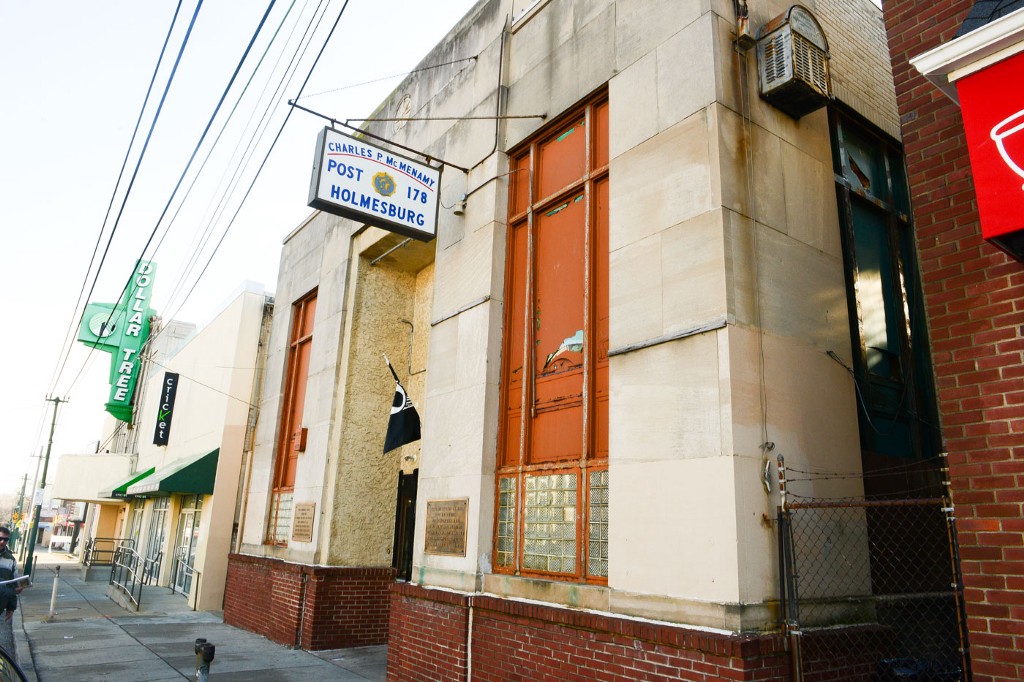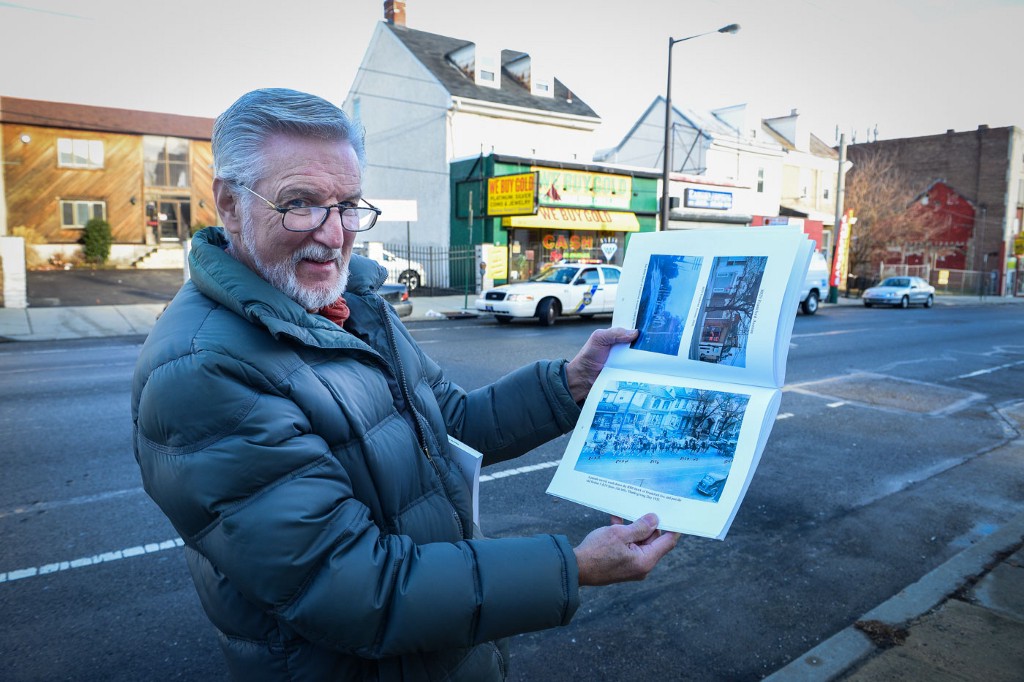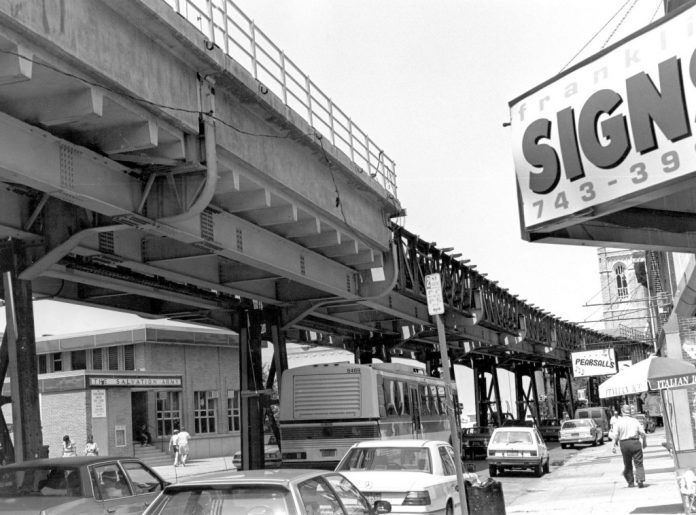All aboard: The El, pictured above in the 1980s, opened in 1922, linking the Northeast with the existing Market Street line. Automobiles were still a rarity at the time, while trains proved too costly or tedious for daily commutes. TIMES FILE PHOTO
At the height of the Roaring ’20s, business leaders in Northeast Philadelphia had some grandiose and sometimes bizarre ideas about their burgeoning yet largely undeveloped community.
Some of their concepts never materialized. For example, prominent Realtor Hamilton R. Disston, grandson of the Disston Saw Works founder, wrote enthusiastically of local housing development for a 1928 prospectus published by the Greater Northeast Philadelphia Chamber of Commerce:
The possessor of a small house in the Northeast is indeed the owner of a “Castle of his own;” one in which he may enjoy the comforts of electricity, modern plumbing and heating, such as are unknown in many real castles throughout the Old World. He has space therein to keep his automobile; for his laundry; for his radio, and, when the rapidly advancing times warrant or require it, there will, no doubt, be space on the roof for his airship.
The stock market crash of 1929 and Great Depression probably ended talk of personal airships for awhile. But the belief that the Northeast was a community on the cusp of a residential, commercial and social explosion remained just as valid five years later when a Temple University journalism student named Richard Thorpe Lawson founded a four-page newspaper that would become the Northeast Times, a periodical that today celebrates its 80th anniversary.
Little if anything is known about Lawson’s initial expectations, whether he viewed the project as more a learning exercise or a long-term business opportunity, a chance to capitalize on the community’s impending growth. But local historians, both professional and self-trained, have authored volumes about what the Northeast looked like back then with its dense population centers, small towns, isolated villages and sprawling farmlands.
Although the term Northeast has been applied liberally to neighborhoods as far-reaching as Fishtown, Kensington, Port Richmond and Olney, “Most city planners and historians agree that the southern boundary of the Northeast is the Frankford Creek,” said Jack McCarthy, a professional archivist and historian and president of the Friends of Northeast Philadelphia History.
By that measure, the area covers about 47 square miles bounded by the creek, the Delaware River and Bucks and Montgomery counties. In the early 1930s, the Northeast featured large mini-cities like Frankford, Tacony and Holmesburg; quaint towns like Fox Chase, Bustleton and Somerton; and rustic villages such as Torresdale, Byberry and Mechanicsville. New residential blocks and commercial districts were being built around Oxford Circle, along Rising Sun Avenue and in Mayfair, but agriculture still dominated most of the landscape, particularly in the northern portion of the district, while a growing network of rails and roads were bringing everyone closer together.
According to McCarthy, Frankford had long been considered the gateway to the Northeast and its “economic engine.” The community originated in the mid-1600s when Swedish settlers built a grist mill on the creek. William Penn and his Free Society of Traders bought the mill in 1687. Throughout Colonial and Revolutionary times, Frankford served as a vital rest stop and meeting venue on the road between Philadelphia and New York known as the King’s Highway. The road would later be renamed Bristol Pike, then Frankford Avenue.
Frankford incorporated as a borough in 1800 and continued to grow as workers flocked to new textile mills, the Frankford Arsenal and other industries. In addition to the European influence, African-Americans were a significant segment of the population and established the Campbell AME Church (the former Second Bethel Church) in 1804. In an 1854 consolidation of Philadelphia County, Frankford and the rest of the Northeast became part of Philadelphia city.
By the early 20th century, it remained the most important population, commercial and cultural center in the Northeast. The Greater Northeast Chamber was based there. It was also home to the Northeast’s first and largest bank, the nation’s first savings and loan, a literary society, a symphony orchestra, a historical society and even a pro football team. The Frankford Yellow Jackets, who actually played home games in largely undeveloped Wissinoming, won the NFL championship in 1926 but folded five years later.
Frankford already was bustling when the El opened in 1922, linking the Northeast with the existing Market Street line. Automobiles were still a rarity at the time, while trains proved too costly or tedious for daily commutes.
“It was enormous in opening up the Northeast,” McCarthy said. “The Frankford El meant you could work in Center City and live in the Northeast.”
Public works continued to define the Northeast in the late ’20s, as Roosevelt Boulevard was constructed as far as Pennypack Circle and the Tacony-Palmyra bridge completed in 1929. Frankford was the hub, much as it remains today with Adams Avenue, Oxford Avenue and Torresdale Avenue all emanating from the neighborhood.
“The Northeast was poised for growth. Then the Depression hit, followed shortly thereafter by World War II. (Growth) didn’t stop completely, but it really curtailed,” McCarthy said.
About three miles north on Frankford Avenue, another Colonial-era community, Holmesburg, was growing beyond its traditional confines.
“The village ran from the (Pennypack) Creek to Decatur Street. That had been the historic village,” said Fred Moore, a local historian and former president of the Holmesburg Civic Association. “Everything north of the creek was farmland. By the ’30s, they were expanding south with Mayfair going in.”
Like Frankford, Holmesburg originally grew around a mill. It was built in 1697 on the Pennypack, as were a dam and the stone Frankford Avenue Bridge, which today is the nation’s oldest roadway bridge in continuous use. Eventually, local resident John Holme bought the mill. The surrounding community was named for him. Moore notes that John Holme had no family relation to William Penn’s surveyor general, Thomas Holme, who also figures prominently in Northeast history.
Commerce and population grew rapidly in the 1880s and ’90s, according to Moore. Trolley service came to the avenue in 1918. Holmesburg had its own post office, theater, bank, American Legion hall, schools and churches of various denominations, including Episcopal, Methodist, Baptist, Presbyterian and Catholic. The neighborhood had a healthy diversity with an African-American community centered around the Mount Zion Baptist Church.
“Holmesburg was a dense village from the late 19th century on,” Moore said. “Rhawn Street had a lot of houses, big houses, and families lived down through Torresdale (Avenue). And industry had come.”
The neighborhood had a complex of textile-related businesses, including a dye works.
“The creek ran red, green or blue depending what dye they ran that day,” Moore said.
Other prominent companies included a granite quarry at the present-day site of Ramp Playground and American Manganese. Yet in terms of widespread notoriety, even these large operations paled in comparison to the area’s most prominent landmark, the Holmesburg Prison.
“By the 1930s, Holmesburg was probably associated as much for the prison as the village itself, and infamously so,” Moore said.
Industry was also driving development of another newer population center on the road between Frankford and Holmesburg. As detailed in an article by Louis M. Iatarola Jr. elsewhere in this issue, the place-name Tacony dates at least to the late 17th century. But it wasn’t until the arrival of Henry Disston in 1871 that the modern community began to take shape. Disston created what would become the world’s most productive saw works while pioneering the concept of a utopian company town.
Disston initially bought 40 acres. He built his plant between the river and the railroad, a park, Victorian homes for his executives and high-density homes for his workers.
“As far as residences, we’re left with a very significant stock of those houses,” said Iatarola, a board member of the Historical Society of Tacony. “On any given block, you can see evidence of these grand singles and twins that housed executives.”
Disston’s heirs still controlled the original estate in the early 1930s, although some things had begun to change. The original business district along Longshore Avenue had been replaced by new shops along Torresdale Avenue. And Disston’s original deed restriction on alcohol had been allowed to lapse with several public drinking establishments operating in the post-Prohibition era. The temperance movement won out in the end, however, as the Pennsylvania Supreme Court shut down the pubs later in the decade.
“We don’t have a pedigree that we were a walkable neighborhood in the 1850s like Holmesburg and Frankford were, but we caught up quickly,” Iatarola said. “By the 1900s, I think we were the envy of those neighborhoods.” ••

Holmesburg’s American Legion post occupies the former Holme Theatre, an Art-Deco style movie house built in 1929 at 8041 Frankford Ave. MARIA POUCHNIKOVA / TIMES PHOTO

Historian Fred Moore explains the significance of buildings along Frankford Avenue. MARIA POUCHNIKOVA / TIMES PHOTO





